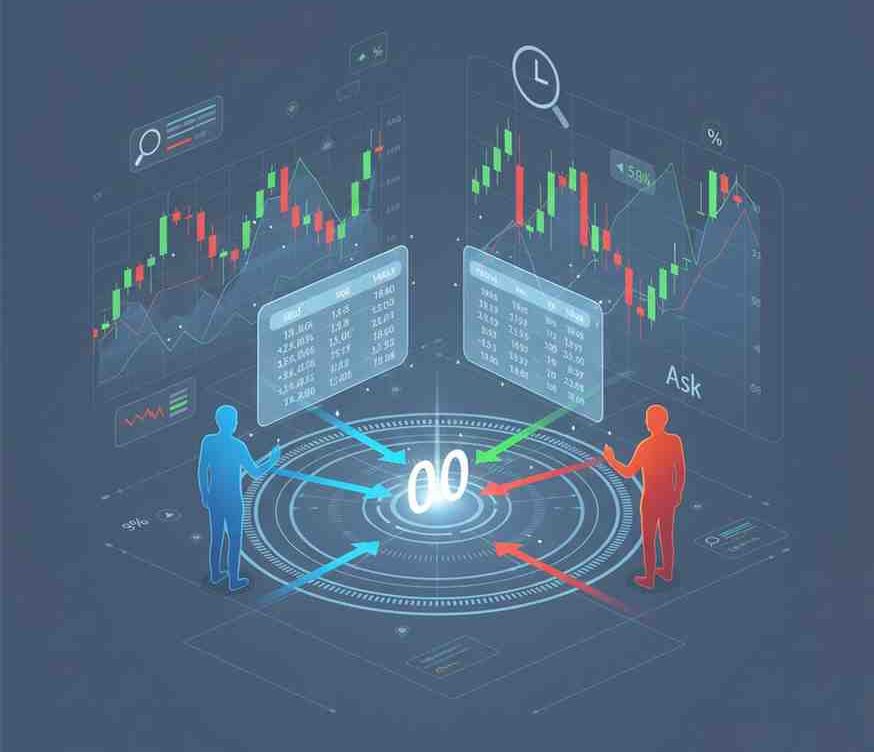
What Is an Auction Market and How Does It Work?
What Is an Auction Market and How Does It Work?
If you have ever watched a live auction, you already understand the basic logic of an auction market. Instead of artwork or antiques, financial auction markets deal in shares, bonds, and other securities. In this environment, prices are not fixed; they constantly evolve as buyers and sellers negotiate in real time, trying to find a level that both sides consider fair.
Thank you for reading this post, don't forget to subscribe!In simple terms, an auction market is a marketplace where buyers submit bids (the highest price they are willing to pay) and sellers submit offers or asks (the lowest price they are willing to accept). A trade happens only when a bid matches an offer, and that matched price becomes the current market price for that security at that moment. This continuous interaction is what drives price discovery and makes the auction market such an important part of modern financial systems.
Core Idea: Markets as Continuous Auctions
Auction Market Theory (AMT) views financial markets as a never-ending sequence of auctions rather than a static list of prices. Instead of thinking “the market decided this price,” AMT encourages you to think “buyers and sellers negotiated this price.”
Key principles of AMT include:
- The market is a continuous auction where buyers and sellers constantly negotiate prices.
- Prices move in response to demand–supply imbalances.
- The goal of the market is to discover a fair value – the price level at which the maximum number of trades can take place.
- Traders can use these dynamics to identify potential profit and risk zones.
From a trader’s perspective, AMT provides a structured way to read the market. Instead of seeing price movements as random noise, you begin to interpret them as the result of buyers and sellers actively competing, adjusting their expectations, and eventually settling around a temporary equilibrium.
How an Auction Market Functions in Practice
To understand how an auction market functions, imagine a typical trading session on a major stock exchange.
- Continuous bids and offers
- Buyers place bids at various price levels based on how much they are willing to pay.
- Sellers place offers at the prices at which they are willing to sell.
The order book collects these bids and offers and ranks them by price and time priority.
- Price discovery through matching
- When the highest bid equals the lowest offer, a trade is executed.
- That transaction price becomes the current reference price in the market.
If no match occurs, orders remain pending until a suitable counter-order appears or the trader modifies or cancels the order.
- Fair value and Point of Control
Over time, a price zone where the highest trading activity occurs often emerges. Traders sometimes refer to this as the “Point of Control” or an area of balance. It is where both sides feel relatively comfortable trading, and it often acts as a reference point for future price action. - Role of time, price, and volume
- Price reflects the level at which buyers and sellers agree.
- Volume shows how committed participants are at a particular level – higher volume often signifies stronger conviction.
- Time reveals how long the market spends at certain prices, helping identify balanced vs. imbalanced conditions.
For example, consider a stock with buyers bidding at ₹95, ₹98, and ₹100, and sellers offering at ₹102, ₹104, and ₹106. No trades occur until a buyer raises a bid to ₹102 or a seller lowers an offer to ₹100. When a buyer is willing to pay ₹102 and matches the lowest offer, a trade is executed at ₹102 – that becomes the latest traded price.
A Simple Case Study: Matching Orders in an Auction Market
Take a hypothetical company, ABC Ltd. Suppose the following orders are in the market:
- Ten buyers place bids at ₹10, ₹20, ₹30, ₹40, up to ₹100.
- Ten sellers place offers at ₹15, ₹25, ₹60, and ₹120.
The market will seek a price where at least one buyer’s bid matches a seller’s offer. If a buyer is willing to pay ₹60 and a seller is ready to sell at ₹60, the trade is executed at ₹60. All unmatched orders remain pending. After this trade, ₹60 becomes the reference price and may influence subsequent bids and offers as participants recalibrate their expectations.
This type of mechanism is what you see on major auction-based exchanges, where many buyers and sellers compete simultaneously. The process is transparent and rule-driven, rather than negotiated privately.
Key Participants in an Auction Market
Several types of participants keep the auction market functioning smoothly:
- Stockbrokers: Registered intermediaries who route investors’ buy and sell orders to the exchange. They enable retail and institutional clients to participate in the auction.
- Institutional investors: Entities such as mutual funds, banks, and insurance companies, often trading in large volumes with strategic objectives.
- Retail investors: Individual investors who participate on a smaller scale, typically entering orders through brokers or online platforms.
- Stock exchanges: The central venues where orders are listed, matched, and executed under defined rules.
- Market makers: Entities that continuously quote both bid and ask prices to provide liquidity and reduce excessive price gaps.
- Depositories and depository participants: They hold securities in electronic form and handle settlement once trades are executed.
Together, these players create depth and liquidity, ensuring that prices reflect a broad consensus rather than the opinion of a single participant.
Market Profile, AMT, and Trading Strategies
Market profile is a way of organising market data (price, time, and volume) to visualise how the auction process is unfolding. Rather than just looking at a standard price chart, traders use market profile to see:
- Where the market spent the most time.
- Where the largest volumes traded.
- Which areas represent balance (agreement) and imbalance (aggressive buying or selling).
Auction Market Theory suggests that:
- When buyers are dominant, prices tend to rise as they compete to attract sellers.
- When sellers are dominant, prices tend to fall as they compete to find buyers.
- Markets move through cycles: accumulation, markup, distribution, markdown, and then repeat.
On a typical trading day, the market may display different profile shapes:
- Normal day: Prices stay within an initial balance range for most of the session.
- Normal variation day: Prices extend beyond the initial balance but remain relatively contained.
- Trend or double-distribution days: The market shifts from one balance area to another, often with strong directional movement.
Traders using AMT and market profile generally focus on two questions:
- Is the market currently balanced or imbalanced?
- Should I trade expecting mean reversion towards fair value, or should I follow the directional move driven by an imbalance?
In a balanced market, strategies often centre around trading near the edges of the balance and exiting as prices revert toward fair value. In an imbalanced market, traders may look to join the dominant side – for example, buying during a clear buy imbalance as prices move higher in search of new sellers.
Auction Market vs. Order-Driven and Dealer Markets
It is easy to confuse auction markets with other market structures, so it helps to clarify some distinctions.
- In an auction market, price is set where the highest bid meets the lowest offer, with many buyers and sellers interacting directly through a central platform.
- In an order-driven market (like most modern electronic exchanges), an automated system matches orders based on price–time priority using an order book. This is closely aligned with the auction concept but emphasises the automation of matching.
- In dealer or quote-driven markets, dealers or market makers quote bid and ask prices and stand ready to trade with participants. Price here is influenced more by the dealer’s quotations than by direct competition among all buyers and sellers.
- In over-the-counter (OTC) markets, trades are negotiated privately between parties, often via telephone or electronic negotiation, rather than through open, centralised bidding.
Auction markets stand out for their transparency. Participants can see the available bids and offers (subject to the platform’s display rules), which leads to more efficient and fair price discovery.
Why Auction Market Theory Matters for Traders and Investors
For active traders and professional investors, understanding auction market behaviour offers several benefits:
- Better insight into how and why prices move.
- Ability to distinguish between normal fluctuations and meaningful imbalances.
- A framework to design trading strategies that align with real-time demand and supply dynamics.
- Enhanced risk management by recognising areas of strong buyer or seller interest.
At the same time, AMT is not a magic formula. It does not predict the future; rather, it helps interpret current market conditions more intelligently. Traders still need sound risk controls, clear rules, and discipline.
Conclusion
An auction market is a dynamic environment where buyers and sellers continuously negotiate prices through bids and offers, allowing the market to discover fair value in real time. Auction Market Theory and market profile tools help you read this process more clearly, turning what appears to be random price movement into a structured and understandable auction of expectations.
Disclaimer: This blog post is intended for informational purposes only and should not be considered financial advice. The financial data presented is subject to change over time, and the securities mentioned are examples only and do not constitute investment recommendations. Always conduct thorough research and consult with a qualified financial advisor before making any investment decisions.

